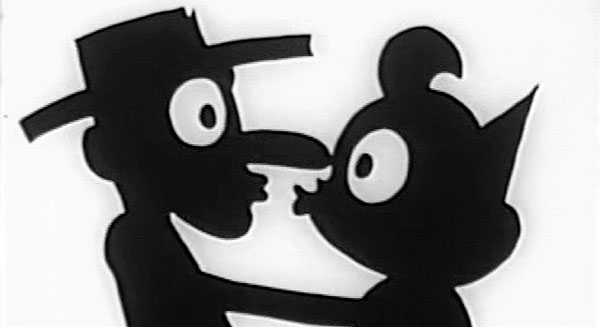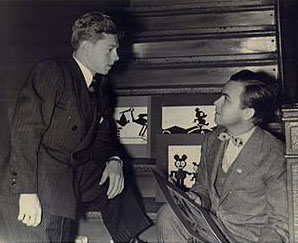
Today in Mark Kausler’s closet we found a real piece of gold: a vintage reel of Otto Messmer animation that was originally shown as animated lights in Times Square.
As most of you know, Felix The Cat master animator Otto Messmer began working for Douglas Leigh (“the Sign King”), the major architect of animated neon signage in New York’s famed Times Square. So famous was Leigh’s work, Warner Bros. made a cartoon parody of his moving signs in Lights Fantastic (1942).

Mickey Rooney (left) with Douglas Leigh and some of Messmer’s art in the background
“It must be considered something of a miracle that this particular job should find its way to Messmer, for he and (Leigh) were obviously perfect match. Here was work incredibly similar to what Messmer did when he first joined Pat Sullivan’s studio nearly a quarter century before; thinking up silent visual gags for black silhouetted characters”.
Messmer worked in his classic style for another 35 years (1937-1973) and it seems, by viewing this video, he never lost his unique storytelling touch. But first – another associated bonus. Kausler also had this rare kinescope of a local New York TV talk show featuring Douglas Leigh himself talking about his Times Square accomplishments.
The 15 minute program, Elosie Salutes The Stars, hosted by Eloise McElhone, which aired September 28th, 1951 on the Dumont network (thank you Don Yowp for helping track down that data) doesn’t mention Messmer or show any of his work, but the stop-motion animation of the deer in the Doeskin tissue commercial is by Lou Bunin.
And its great to see and hear Leigh talk about his work in such a relaxed way.
And here is the Otto Messmer reel. My only other note is to observe how Messmer utilized Max Fleischer’s rotoscope; and to admire his craft. Messmer was a one-of-a-kind animation genius.
(Thanks, Mark Kausler and Don Yowp for making this post possible)


 Jerry Beck is a writer, animation producer, college professor and author of more than 15 books on animation history. He is a former studio exec with Nickelodeon Movies and Disney, and has written for The Hollywood Reporter and Variety. He has curated cartoons for DVD and Blu-ray compilations and has lent his expertise to dozens of bonus documentaries and audio commentaries on such. Beck is currently on the faculty of CalArts in Valencia, UCLA in Westwood and Woodbury University in Burbank – teaching animation history. More about Jerry Beck [
Jerry Beck is a writer, animation producer, college professor and author of more than 15 books on animation history. He is a former studio exec with Nickelodeon Movies and Disney, and has written for The Hollywood Reporter and Variety. He has curated cartoons for DVD and Blu-ray compilations and has lent his expertise to dozens of bonus documentaries and audio commentaries on such. Beck is currently on the faculty of CalArts in Valencia, UCLA in Westwood and Woodbury University in Burbank – teaching animation history. More about Jerry Beck [



































Was that Sonja Heine rotoscoped?Did they reuse it as reference for Disney’s “The Autograph Hound?
It appears to be high-contrast live-action film, with animated transitions cut in.
Jerry, Mark, Yowp: thanks so much for this informative clip!
I’d been curious about the touted number of “4,104 lightbulbs” in the Times Square sign. When I looked carefully at a photographed demo in an old LIFE magazine article, it was clearly visible as 38 x 27, which adds up to only 1026 bulbs (and also, a 1.4:1 aspect ratio that more closely matches a common print resolution of 5″x7″ than the 3:2 aspect of 35mm film frames). Then I read your piece and it struck me: it’s a simple up-res. At twice the width/height, the Times Sq sign was 76 x 54 = 4,104 bulbs. So, there must have been different res versions of the sign.
I can confirm it was 4,104 light bulbs – arranged in an array of 76 columns (each spaced 5″ apart) by 54 rows (4.5″ separating each row) – which would make the dimensions 380″ (31′ 8″) x 243″ (20′ 3″). Except from September 1965 to early 1976, when a clock showing the time down to the nearest one-tenth of a second was installed in connection with Bulova’s Accutron watch advertising on the EPOK, whereby the bottom four rows were deactivated for the duration, thus only 3,800 bulbs (76 x 50) were visible.
That one on the NE corner of 46th and Broadway replaced an earlier EPOK display in the middle of the block between 46th and 47th which was 2,000 bulbs (50 columns by 40 rows, the graphics shown in a 25 x 20 array) and was in use from 1937 to 1940.
There were EPOK signs in other cities too. Sometimes the dimensions and light bulb count matched, other times it didn’t. In Chicago from the mid-1960’s to the early 1970’s, they had a count of 86 columns by 61 rows, or 5,246 bulbs. It was mounted on the corner of North State and East Randolph Streets, atop the Walgreens building at 151 N. State; below it was a “zipper” operated by Life magazine (and controls by Naxon Telesign) which was a sister to the zipper mounted around the Allied Chemical Tower. Douglas Leigh had a hand in that EPOK (and State Street zipper), too. The Chicago EPOK was apparently the place advertisers went because of Bulova’s lock on the Times Square EPOK; advertisers ranging from Delta Air Lines to Mattel toys to Sea & Ski to Coca-Cola (this, in 1969 around the time the longtime Coke ad display at East Randolph between North Michigan Avenue and North Beaubein Court was about to be taken down while the building housing it for decades was being prepared for demolition). I wonder if Messmer’s animation touch extended to those other cities like Chicago, or if it was just confined to those passing by Times Square.
It should also be noted that as of the early 1960’s, there was a “Six Degrees of Felix the Cat” along Times Square. Messmer’s role in animating the silent Felix shorts has been duly noted; but the other Felix connection was via Trans-Lux Corporation, whose “Flashcast” and “Adcast” traveling message signs (made, and their operation controlled by perforators manufactured, by their News-Sign division) accompanied many ad billboards along the square (from Budweiser atop the Brill Building, to the Admiral Television Appliances on 47th Street, to the Kleenex billboard on the NE corner of 43rd and Broadway, to the twin zippers of the TWA billboard across the street on the SE corner), by dint of their syndication of Joe Oriolo’s made-for-TV animated cartoons spotlighting Felix and his “magic bag of tricks.”
P.S. Checking through other articles and all (such as a 1960 article in a Canadian newspaper about their displaying animated film promoting Canada that was animated by a local artist and not Messmer), I’ve found that the EPOK’s dimensions by column (the 76 bulbs across) were actually 4.875″ between bulbs, thus from left to right 30′ 10½” (370.5″); the 4.5″ figure (54 rows down) still holds. This meant the Bulova clock’s dimensions from left to right were 4″ between bulbs, and from top to bottom 3.5″. (Separating by eighths seemed “a thing” in the 1930’s; a device called the “Wondersign” – which in its operating principles [if not specifics] preceded Spectacolor by some nearly four decades – had the bulbs 1.875″ apart both across and down; that had 27,000 bulbs in a 180 x 150 layout, in red, white, amber and green [each 6,750 bulbs]. That piece of machinery – mounted above the RKO Palace Theatre – was first put up in 1939, turned off for the duration of World War II, and after Japan surrendered operation was resumed but deactivated for good by 1948-49.)
Photos taken on a straight path, when highlighting for square in Photoshop, on the EPOK board show a ratio of 12 across and 13 down, which checks out on the 4.875″ x 4.5″ figure.
The 1937-40 Wilson EPOK was actually one of two in that period; prior to the demolition of the Hotel Cadillac in 1940 (situated next door from the Claridge), that building had housed another EPOK since mid-1938, for Old Gold cigarettes, which also had 4,104 bulbs – but only 1,026 photocells (38 x 27), thus 4 bulbs to every “pixel.” While Mr. Messmer handled the cartoons for Wilson and most others up to Bulova, Signs of the Times magazine cited the Old Gold animated cartoons as by “The Little King” creator Otto Soglow. The 4,104-bulb version of the EPOK was first premiered in summer 1937 in front of the Astor Theatre to show animated samples of key scenes from a film playing there at the time, “High, Wide and Handsome.” The increase of photocells to “per bulb” occurred once the EPOK was first installed near the top of the I. Miller building on Broadway and 46th in 1940 with Wilson whiskey as the first advertiser. (By 1960, it was reported in Signs of the Times that the EPOK used 10-watt A21 reflector bulbs manufactured by General Electric. When the clock was installed during Bulova’s time, that clock apparently used 40 watt A21 inside frosted bulbs. It’s possible that before 1957, 25-watt inside-frosted A19’s were used.)
Incidentally, of the Chicago EPOK advertisers, Mattel was the only one to have also been displayed on the Times Square EPOK. It was there for a few short months in Fall 1964, before Bulova settled in for their long run. (The clock, which didn’t appear as part of the display until about September 1965, was controlled by Time-O-Matic to Bulova’s specifications, per a 1966 Time-O-Matic ad and 1970 article about the Bulova ad’s operation, both in Signs of the Times.) The 86 x 61 (5,246 bulbs) was apparently unique to Chicago; an article I saw in Spanish involving an EPOK display in Barcelona had the bulb count as 5,160 (86 x 60).
I came across two pieces of footage showing the animation of the 1937-1940 Wilson Whiskey sign:
1. https://www.youtube.com/watch?v=CMbxXHZLcSA&t=195s
This clip is quite clear and shows a decent sample of the animation. Likely filmed in 1938.
2. https://youtu.be/ZpXnEvW0XD0?si=DhDQaPxI1hSZH6QQ&t=1429
This shorter clip is in color, but suffers from a bad ‘restoration’ that smears its frames together. Likely filmed in 1937.
Do you know of any other footage or documentation of the animation for this earlier sign?
That header still looks to me like a man attempting to kiss a cat girl in secret.
The Otto Messmer Reel when was it produced? and was it ever released any were?
This appears to be a composite of animated bits produced between 1940 (if not earlier) and 1948. Up to that point the products that advertised on the EPOK were Wilson whiskey (1940-42; slogan “That’s All”; they also advertised on the first EPOK beginning about 1938 or so, I think their predecessor in that first EPOK was Old Gold cigarettes) and Schaefer Beer (1945-48, replaced by Philco). The bit in the jungle seems to have run during Wilson’s time there; there’s already a clip of Times Square shot (either on YouTube or on Getty Images or some other site) with the Bo Peep ‘toon, from when Schaefer advertised there.